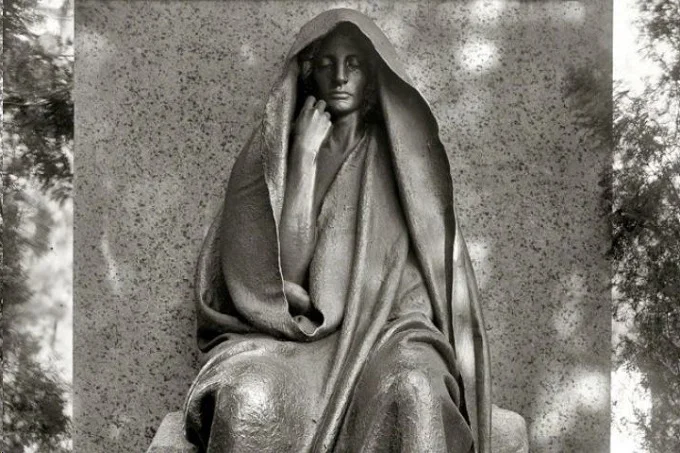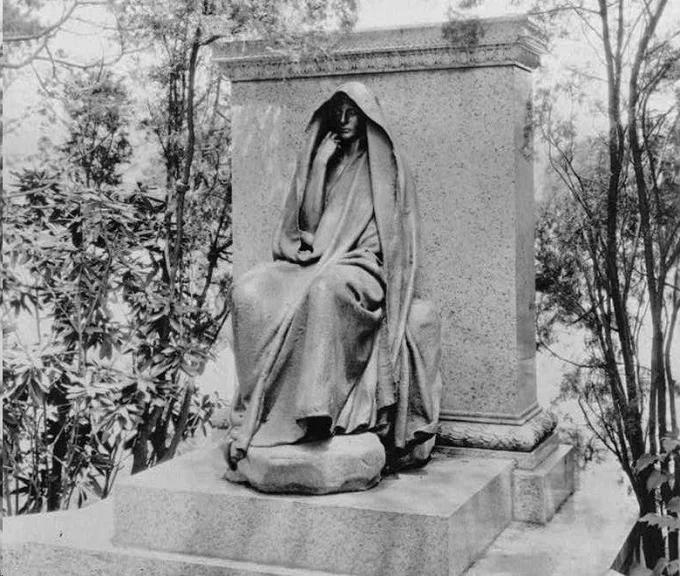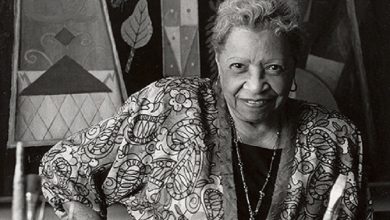Black Aggie: the statue that kills

The legend of Black Aggie is the most famous and scariest story of Druid Ridge Cemetery, Maryland, and even from the looks of it, this statue looks creepy.
The nickname Black Aggie was given by locals to the statue depicting a sad man sitting on a rock, wrapped in his cloak. This sculpture stood for a long time on the grave of General Felix Agnus at Druid Ridge Cemetery in Baltimore, Maryland.
In fact, the figure is only an illegitimate copy of another statue called Grief by the famous sculptor Augustus St. Gaudens, placed in late 19th century Rock Creek Cemetery in Washington, D.C. Very quickly, however, Black Aggie became far more popular than the original. The statue was rumored to have been cursed by someone because of a series of mishaps associated with it.
St. Gaudens sculpted the original “Sadness” statue at the request of the famous American writer of those years, Henry Adams, who wanted to place it on the memorial of his wife, who committed suicide in 1885 with potassium cyanide. After seeing the somber but beautiful creation, Adams paid the sculptor generously and placed “Sadness” on his wife’s grave in Rock Creek.
Some people loved this statue, and people began to specially go to the cemetery to see it and all praised the sculptor and his work.
In 1906, General Felix Agnus of Baltimore wanted to place a similar sculpture on his family memorial and asked sculptor Edward to create an almost complete copy of Sadness. In 1907, the sculpture was completed and installed on Agnus’ grave in Druid Ridge Cemetery.
Soon the widow of St. Agnus somehow found out about it (the sculptor himself had passed away shortly before the copy was installed) and noted that except for minor details, this statue and her late husband’s “Sorrow” were completely identical. She wrote a letter to Agnus in anger and then hired a lawyer to demand the removal of the illegal copy.
However, women had far less rights and influence in those days, so even with the help of a lawyer, St. Gaudens’ widow was ultimately unable to get the copy removed from Agnus’ grave. And in 1925, Felix Agnus himself died, and the sculpture was installed on his common grave with his wife.

As the legend goes, it was then that someone (most likely the widow of St. Gaudens) and cursed the statue, after which frightening phenomena began to happen here.
The first thing the late-night visitors to the cemetery began to notice was that Black Aggie’s eyes glowed red, a particularly ominous sight under his hood. And then word spread that someone had been staring into those red eyes for too long and was soon going blind.
People began to visit Black Aggie more often, especially cynical young men and women. Some of them even climbed onto the statue’s lap to sit on it, others glued papers to the statue, and put hats on their heads. And after a while, each of them either got sick or died or was maimed in an accident.
Months and years passed, and there were more and more such stories. One day a teenager bragged to his friends that he would come to Druid Ridge Cemetery and spend the night next to the statue of Black Aggie. According to this young man, all the stories about the curse and other things were just fiction, and the sculpture was not scary or dangerous in the slightest.
On the day in question, his friends accompanied the boy to the cemetery, and then sat with him at the statue until dusk, having fun while telling various funny stories. Then they left, and the boy was alone.
As night fell, the Druid Ridge Cemetery would close, and the keeper would walk along the paths with a lantern, checking to see if there were any visitors to the cemetery. The boy hid from the watchman behind some bushes and then climbed out again and sat down next to Black Aggie.
No one knows what happened next, but at midnight a chilling scream resounded over the graves, and when the watchman ran to the place from which the scream came, he saw the lifeless body of a teenager lying on the ground next to Black Aggie.
The expression on the corpse’s face would have frightened even the sighted; his eyes were wide open, as was his mouth, as if frozen in screaming. Not a single wound was found on the body; apparently, the lad had died of fright.

One afternoon another group of young boys came to Black Aggie, and one of them began to say that cowards made up all the scary stories about Black Aggie, and then he put out his cigarette on the hand of the statue. A few days later, this guy was found dead, and it was unknown what he had died of.
The more such tales became, the more actual vandals came to the cemetery. In 1962, someone sawed off the hand of a statue with a hacksaw, and when he was caught red-handed, he asserted that an unknown force had made him do it.
Nevertheless, because of such attacks on the statue, the descendants of the Agnus family decided in 1967 to remove Black Aggie from his tombstone and gave the sculpture to the Smithsonian Institute from where it was later moved to the yard of the Dolly Madison mansion in Lafayette Square in Washington where it remains to this day.




